
The Mountain Eagle
WHITESBURG, LETCHER COUNTY, KENTUCKY.
156 years of courthouses
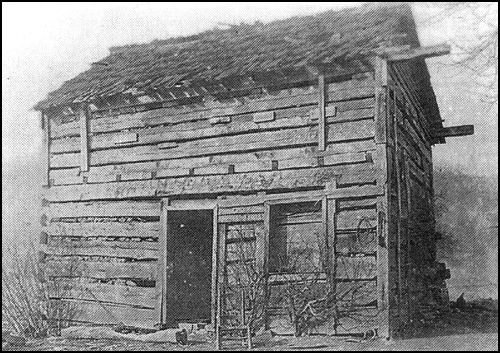 |
The first court held in Letcher County after it because a county was in 1842 at the home of Mose Adams (above) opposite the mouth of Pert Creek. This building was torn down in 1928. |
![]() "Traditionally, it has been said that court was held under a huge beech tree near Mose Adams's home during warm and dry weather and in his log house when the weather was bad. This old house was built by Adams about 1812 and was torn down sometime in 1928. Nathaniel Collins, son of the old settler, James Collins, was chosen as the first presiding judge. Collins was born on the Camp Branch section of Rockhouse Creek in 1814 and died in this county in 1905. The oldest court records obtainable show that the first court was held in October, 1843, although a semblance of court must have been held sometime earlier that year. Collins served as judge for over 10 years and was replaced by Joseph E. Cornett (1814-1891), the youngest son of William Cornett (an early settler). Cornett helped in 'laying out' Whitesburg as a town during his term in office," wrote William T. Cornett.
"Traditionally, it has been said that court was held under a huge beech tree near Mose Adams's home during warm and dry weather and in his log house when the weather was bad. This old house was built by Adams about 1812 and was torn down sometime in 1928. Nathaniel Collins, son of the old settler, James Collins, was chosen as the first presiding judge. Collins was born on the Camp Branch section of Rockhouse Creek in 1814 and died in this county in 1905. The oldest court records obtainable show that the first court was held in October, 1843, although a semblance of court must have been held sometime earlier that year. Collins served as judge for over 10 years and was replaced by Joseph E. Cornett (1814-1891), the youngest son of William Cornett (an early settler). Cornett helped in 'laying out' Whitesburg as a town during his term in office," wrote William T. Cornett.
![]() The Hogg property was chosen as the site for the county seat, which was named Whitesburg in honor of Daugherty White, a legislator from Goose Creek in Clay County, who had worked in the General Assembly to help create the new county. The state government named a commission of five men, natives of the area, to establish the boundaries of the new county. Four of the members were Nathaniel Collins, Hiram Hogg, Benjamin Adams and Benjamin Webb, according to Cornett.
The Hogg property was chosen as the site for the county seat, which was named Whitesburg in honor of Daugherty White, a legislator from Goose Creek in Clay County, who had worked in the General Assembly to help create the new county. The state government named a commission of five men, natives of the area, to establish the boundaries of the new county. Four of the members were Nathaniel Collins, Hiram Hogg, Benjamin Adams and Benjamin Webb, according to Cornett.
![]() Once the boundaries were established, the local officials took bids in 1843 for the erection of a courthouse. Cornett quotes Cro Caudill as telling him that Ephraim Hammonds got the job. But Hammonds became swamped in debt and had to give up his contract shortly before the building was completed. The Rev. John A. Caudill finished the building sometime early in 1844 and "was paid rather handsomely, for that day and time, for his services."
Once the boundaries were established, the local officials took bids in 1843 for the erection of a courthouse. Cornett quotes Cro Caudill as telling him that Ephraim Hammonds got the job. But Hammonds became swamped in debt and had to give up his contract shortly before the building was completed. The Rev. John A. Caudill finished the building sometime early in 1844 and "was paid rather handsomely, for that day and time, for his services."
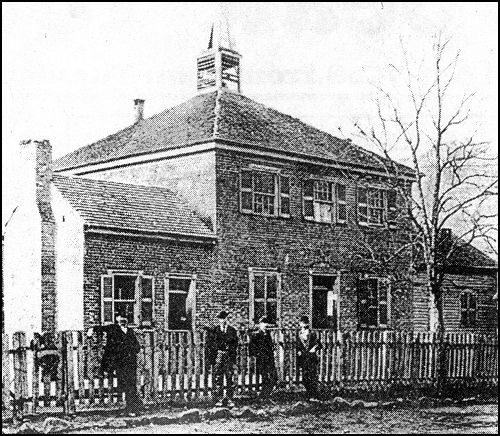 |
The first courthouse built in Letcher County was this structure made of wood and located in the newly designated county seat of Whitesburg. The building was finished in 1844 and was used until 1897, when it was torn down to make room for a new one. |
![]() "Edward (Ned) Polly, then past eighty, was awarded the commission to build the first jail, but left this work up to his sons," Cornett says. He puts the "total cost" at about one hundred dollars, but the text is not clear as to whether that covered both buildings or only the jail.
"Edward (Ned) Polly, then past eighty, was awarded the commission to build the first jail, but left this work up to his sons," Cornett says. He puts the "total cost" at about one hundred dollars, but the text is not clear as to whether that covered both buildings or only the jail.
![]() Both the courthouse and the jail were built of logs. The courthouse, which had plank trimming, was torn down in 1897 because of its dilapidated condition.
Both the courthouse and the jail were built of logs. The courthouse, which had plank trimming, was torn down in 1897 because of its dilapidated condition.
![]() Construction began in 1898 on a new brick courthouse. Anthony Day told Cornett the work was headed "by a practical architect named Lewis (or Lemuel) R. Perry, who put his initials on the keystone over the front entrance." Bricks for the building were made next to the site. In mid-1899 the government began to move into the new courthouse, which, Cornett said, "was considered one of the best and most well-built in the state."
Construction began in 1898 on a new brick courthouse. Anthony Day told Cornett the work was headed "by a practical architect named Lewis (or Lemuel) R. Perry, who put his initials on the keystone over the front entrance." Bricks for the building were made next to the site. In mid-1899 the government began to move into the new courthouse, which, Cornett said, "was considered one of the best and most well-built in the state."
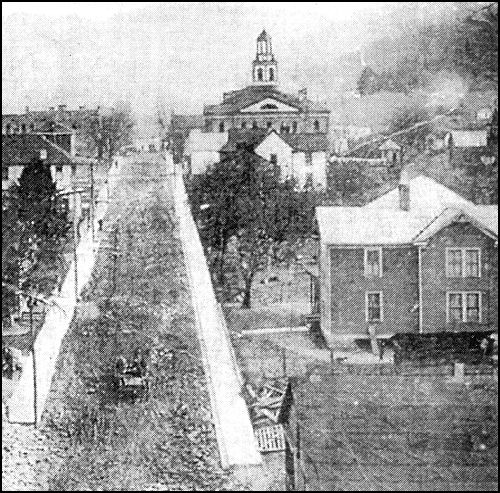 |
In 1898 construction began on the courthouse seen at the top center of this picture. Apparently the building was located on the site of the first one. A bell in the large cupola called jurors to court. This view is from the end of Main Street, just across the Kentucky River from present-day Fields Cliff. Wooden sidewalks are on both sides of the street. This photo was taken sometime after 1907. |
![]() "It had a huge cupola which sat directly above the courtroom and had a belfrey in which the bell used to 'call the court' to session was positioned. The yard around the building was enclosed by an iron fence set in raised concrete, giving the appearance of a square. This yard was sown in grass and shaded by maple trees on all four sides. (Later, seemingly one by one, these trees were cut down so that when the old courthouse was razed only three were left standing.) Flowers were grown around the foundation of the building and around the fence," Cornett wrote.
"It had a huge cupola which sat directly above the courtroom and had a belfrey in which the bell used to 'call the court' to session was positioned. The yard around the building was enclosed by an iron fence set in raised concrete, giving the appearance of a square. This yard was sown in grass and shaded by maple trees on all four sides. (Later, seemingly one by one, these trees were cut down so that when the old courthouse was razed only three were left standing.) Flowers were grown around the foundation of the building and around the fence," Cornett wrote.
![]() The courthouse was heated by fireplaces and stoves until an addition was built at the back of the original building in 1936-37 by the Works Progress Administration (WPA), a federal agency. The addition had a furnace which heated both the old and new portions.
The courthouse was heated by fireplaces and stoves until an addition was built at the back of the original building in 1936-37 by the Works Progress Administration (WPA), a federal agency. The addition had a furnace which heated both the old and new portions.
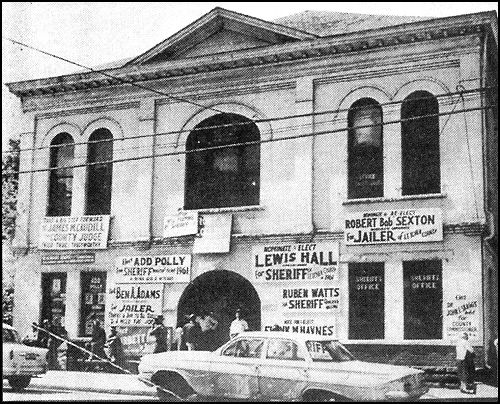 |
During the 1930's the federal Works Progress Administration financed the addition of more office space at the rear of the courthouse. By the early 1960's the courthouse was run down and ready for replacement. The cupola was no longer on the building and political signs covered the front during election campaigns. In 1964 the federal Area Redevelopment Administration made a grant to Letcher County to demolish this courthouse and build a new one. |
![]() By the 1960s the courthouse was out of date and too small, and another federal government program, the Area Redevelopment Administration, provided money to raze the old courthouse and build a new one. (The ARA was an agency created by the administration of President John F. Kennedy to provide employment and improvements in depressed areas of the United States.)
By the 1960s the courthouse was out of date and too small, and another federal government program, the Area Redevelopment Administration, provided money to raze the old courthouse and build a new one. (The ARA was an agency created by the administration of President John F. Kennedy to provide employment and improvements in depressed areas of the United States.)
![]() William Banton Moore, a Louisville architect, designed the new building and Ramsey and Clubb Construction Co. of Shelbyville built it. The work began in 1964 and the building was dedicated on April 3., 1965. Kentucky Gov. Bert T. Combs was the principal speaker.
William Banton Moore, a Louisville architect, designed the new building and Ramsey and Clubb Construction Co. of Shelbyville built it. The work began in 1964 and the building was dedicated on April 3., 1965. Kentucky Gov. Bert T. Combs was the principal speaker.
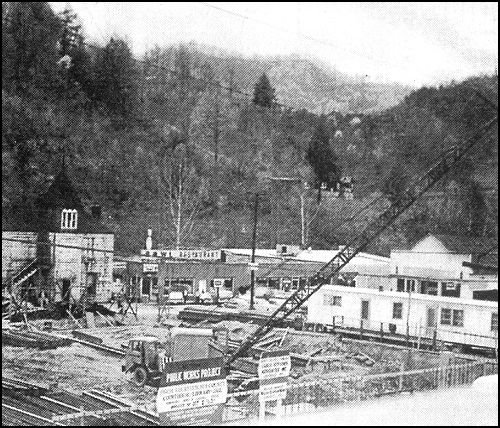 |
The photo above shows the early excavation necessary to construct the 1960's courthouse. The building with a tower at the rear of the excavation is the old Letcher County jail, a stone structure built in 1907 just behind the courthouse. By the '60's, the jail was in such bad repair that prisoners had little difficulty in pushing the bars apart, climbing out the windows and sliding down a rope of sheets to freedom. |
![]() The new contemporary-design courthouse, which was faced in blue and beige panels, also contained space for a new jail on the top floor and a public library on the ground-level floor at the rear of the building.
The new contemporary-design courthouse, which was faced in blue and beige panels, also contained space for a new jail on the top floor and a public library on the ground-level floor at the rear of the building.
![]() The jail replaced a stone jail which was built in 1907 just across the street from the rear of the courthouse. That building was remodeled in 1923. It was the third Letcher County jail building. The first one, according to Cornett, was completed in 1844 or 1845 and was burned by a band of guerrillas in July, 1864, during the Civil War. Another building, also of logs but later covered with planking, was built shortly afterward and stood until about 1907.
The jail replaced a stone jail which was built in 1907 just across the street from the rear of the courthouse. That building was remodeled in 1923. It was the third Letcher County jail building. The first one, according to Cornett, was completed in 1844 or 1845 and was burned by a band of guerrillas in July, 1864, during the Civil War. Another building, also of logs but later covered with planking, was built shortly afterward and stood until about 1907.
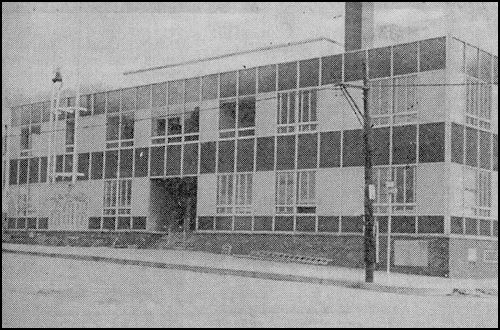 |
The new courthouse built in the 1960's was covered in blue and beige panels which some local residents thought made it look more like a filling station than a courthouse. The building was dedicated in April of 1965. By the mid-1990's, the courthouse and in particular the county jail were badly in need of renovation. |
![]() Caudill quotes Fess Whitaker, who served as jailer, as saying that metalwork for the jail built in 1907 was "carried to Letcher County from Lexington on the backs of 'Fightin' George Ison and Gudson Ingram."
Caudill quotes Fess Whitaker, who served as jailer, as saying that metalwork for the jail built in 1907 was "carried to Letcher County from Lexington on the backs of 'Fightin' George Ison and Gudson Ingram."
![]() By the 1990's the courthouse built in 1964 was worn out, and state officials were threatening to close the third-floor jail. County officials were able to obtain federal assistance in remodeling and changing the 1964 courthouse into the new courthouse which was formally opened earlier this month {October}.
By the 1990's the courthouse built in 1964 was worn out, and state officials were threatening to close the third-floor jail. County officials were able to obtain federal assistance in remodeling and changing the 1964 courthouse into the new courthouse which was formally opened earlier this month {October}.
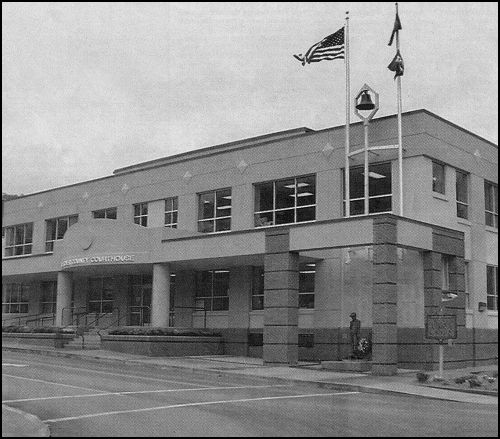 |
Earlier this month {October} the newly remodeled 1960's courthouse was rededicated. The remodeling moved the jail from the top floor of the courthouse to the lower floor, which is on street level at the rear of the building, and traded the shiny blue and beigh panels for a tan masonary-like exterior. A statue honoring veterans of all wars was moved from the east to the west end of the front of the building. The bell in the front is the same one which called jurors to court in the 1898 courthouse. |
Return to
Letcher County, KY, Genealogy
Home Page